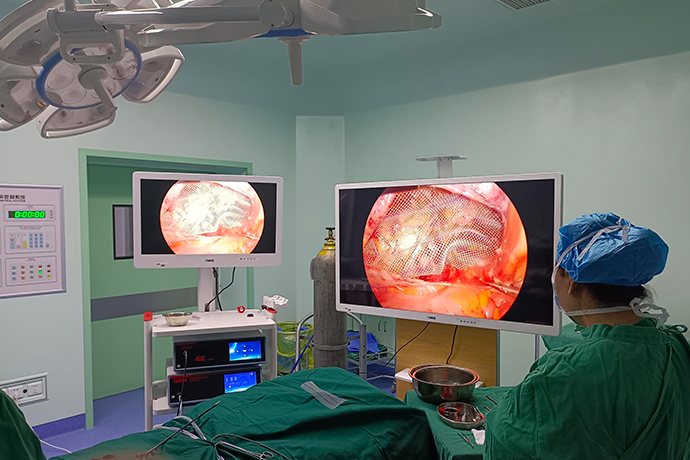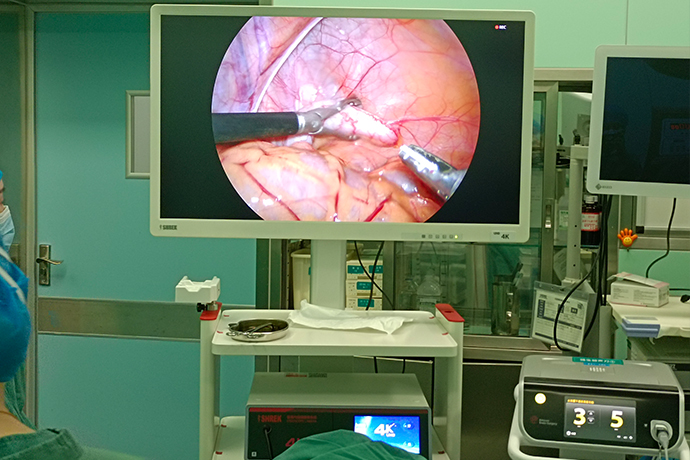【4k Basics】4K, 3D, Disposable Endoscope
Release time: 23 Mar 2022 Author:Shrek
The main points
CMOS, 4K, 3D and computer technologies have achieved breakthroughs and are gradually applied in the field of endoscopy.
The field of disposable endoscope is one of the few endoscope segments in my country that is at the leading level in the world.
4K ultra-high-definition endoscopy and 3D endoscopy are moving towards integration, and "4K+3D" will become the mainstream in the future.
The endoscopic AI-assisted diagnosis system focuses on the digestive tract, and the future broad market will be at the grassroots level.
The domestic endoscope field is hot in financing, and disposable endoscopes and 4K ultra-high-definition endoscopes have attracted much attention.

Innovation driver for endoscopy
According to the development history of endoscope, the leap-forward iteration of endoscope originated from the most primitive technological breakthrough. Today, various cutting-edge technologies such as CMOS technology, 4K technology, 3D technology, artificial intelligence technology, big data technology, and deep learning technology are becoming more and more mature and gradually applied in the field of endoscopy, laying a technical foundation for the innovation of endoscopy.
On the other hand, the continuous growth of the endoscope market size provides a broad space for endoscope companies to seize the market, obtain profits and create wealth, while the demand for profit and wealth creation drives endoscope companies to continuously innovate products. Make it take the initiative in the market competition.
At the same time, various factors, such as changes in consumer behavior, clinical demand upgrades, capital bets, policy support, and corporate competition, drive endoscopy companies to continue to innovate.
Compared to two decades ago, clinical needs have changed dramatically. For doctors, they need clearer, more stereoscopic (three-dimensional) images with more parameters; for patients, they need safe, painless, and timely feedback endoscopic diagnosis and treatment.
In addition, the fluoroscope (working spectrum is 400-900nm) has a wider working spectrum than the traditional white light microscope (working spectrum is 400-700nm), so it can show the image of the surface layer of human tissue and the fluorescence imaging of the tissue below the surface, such as the gallbladder Vessels, lymphatic vessels, and blood vessels are visualized; white light microscopy mainly displays surface images of human tissues. Therefore, fluoroscopy has become more and more widely used in clinical practice.
In response to the need for more safety, many companies have developed disposable endoscopes, which solve the problem of cross-infection in endoscopy and treatment, and improve safety.
For disposable endoscope companies, innovation is still needed to ensure that the imaging quality and functions of existing endoscopes are not inferior to those of existing endoscopes at low cost.
For capsule endoscopy companies, expanding indications, ensuring inspection accuracy, and assisting in image reading are their innovative directions.
In response to the need for timely feedback, the AI-assisted diagnosis system can help doctors diagnose more efficiently, quickly and accurately.
4k Ultra HD Endoscope System
The difference between 4K ultra-high-definition endoscope and traditional high-definition endoscope is only the soft features such as image resolution and color reproduction. Therefore, 4K ultra-high-definition endoscopy has the same indications as traditional high-definition endoscopy, but in specific situations such as high-definition endoscopy cannot meet existing clinical needs, 4K ultra-high-definition endoscopy has an irreplaceable role.
4K UHD endoscopy produces images with four times the resolution of conventional HD endoscopy images. Based on higher resolution, 4K ultra-high-definition endoscopy can observe the level of fine blood vessels, nerves and fascia, and can also observe the details of lesions and biopsy sites that are difficult to explore with traditional high-definition endoscopy.
The 4K ultra-high-definition endoscope can faithfully reproduce the color of the image. 4K ultra-high-definition endoscopes have a wider color gamut than traditional high-definition endoscopes, which can faithfully reproduce the images captured by the endoscope system. Compared with traditional endoscopy, 4K ultra-high-definition endoscopy is based on higher resolution, visual acuity, and color resolution, which can provide a better sense of depth and intraoperative operation.
For example, the visual field of laparoscopic surgery is rich in color levels, and 4K laparoscopy helps to distinguish subtle differences in pancreatic tissue and adipose tissue based on real colors.
4K ultra-high-definition endoscopy has higher recognition for anatomical levels and blood vessels. Based on comprehensive advantages such as image resolution, color resolution, and visual delicacy, 4K ultra-high-definition endoscopy can identify small parts such as lymph, fascia, blood vessels, and nerves.
For example, 4K laparoscopy can more clearly identify and predict the branch of the anterior superior pancreaticoduodenal vein behind the right gastroepiploic vein and on the surface of the pancreas, and avoid unnecessary venous branches when dealing with the right gastroepiploic vein. The injury of the lower mediastinal lymph nodes through the esophageal hiatus approach can identify and identify the important organs and fascia in this anatomical area.
4K ultra-high-definition endoscopes improve surgical precision. Clinically, 4K ultra-high-definition endoscopy can provide doctors with a clearer surgical field of vision and images, and the ultra-high-definition images enhance the sense of depth of the picture. With the image magnification function, it can provide doctors with better positioning and orientation, thereby improving the operation. Accuracy.
For example, 4K laparoscopy is more recognizable than traditional high-definition laparoscopy, and the probability of intraoperative errors is lower. It can assist clinicians in identifying the relationship between important anatomical structures and surrounding tissues, and avoid damage to nerves, blood vessels, lymph nodes and other parts.
4K ultra-high-definition endoscopy can be applied to a wider range of clinical scenarios. Based on the image quality and clarity of 4K ultra-high-definition endoscopes, it can be used for delicate operations that are difficult to operate with traditional endoscopes, such as neurovascular surgery.
At the same time, 4K ultra-high-definition endoscopy is based on the characteristics of clearly displaying or identifying membranous anatomical layers, fine blood vessels, nerves, and the boundaries of lymph node dissection. Practical value.
Regarding the development trend of rigid endoscopy, in addition to 4K, the other is this fluoroscopic endoscope, also called ICG, which is a high-end representative of the development of laparoscopy. The development of laparoscopy in recent years has mainly changed from ordinary endoscopy to 3D, 4K, and ICG are developed in several directions, and they all have special clinical effects. 3D is mainly to give young doctors more intuitive effects and shorten the operation time. 4K, because of the advantages of resolution, three-dimensional, layered, and better clarity, enhances the judgment during the operation, and the doctor has more confidence. However, the 4K system should be the most core and most basic product in the surgical endoscope, which is equivalent to a core platform. 3D and ICG have a certain proportion, but they are all relatively special applications.
Disposable endoscope
Among the large and small medical devices, there is such a product. It is equipped with a small lens, which enters the human body from the natural orifice of the human body or through a small surgical incision, and directly peeks into the organ to be examined. It is called the doctor's "eye". ". It is an endoscope, a medical device that patients often use in their daily visits.
In modern medicine, endoscopy is the golden means of early cancer screening and minimally invasive surgery. It can see lesions that cannot be displayed by X-rays. "Medical experts generally believe that nowadays, in general surgery, obstetrics and gynecology, urology, thoracic surgery, orthopedics and other surgical departments, whether it is for examination or minimally invasive surgery, laparoscopy, thoracoscopy, and hysteroscopy are inseparable. and the help of endoscopes such as arthroscopy.
Endoscopes have been used for over a hundred years. Generally speaking, it is mainly composed of components such as the host and mirrors, which belong to large medical equipment and are the fixed assets of medical institutions. In recent years, an emerging, consumable disposable endoscope has begun to be used in clinical experiments and some diagnosis and treatment fields.
Disposable endoscopes address the risk of cross-infection common to traditional endoscopes.
As a precision instrument that penetrates deep into the human cavity, endoscopes can easily lead to cross-infection events. For example, in the "Top Ten Medical Technology Hazards" published annually by the American Institute of Emergency Medicine, the problem of cross-infection caused by endoscopes is listed all year round.
The top ten medical technology hazards in 2016 are: Incomplete cleaning of flexible endoscopes before disinfection can spread deadly pathogens; No. 2 in 2017: Incomplete cleaning of complex reusable medical devices can cause patient damage Infection; ranked second in 2018: incomplete cleaning and disinfection of endoscopes exposes patients to the risk of infection; ranked fifth in 2019 is that improper operation of sterile soft scopes can lead to patient infection.
Among them, flexible endoscopes with multiple thin and long channels are more difficult to clean and disinfect, and are more likely to cause cross-infection events, such as cystoscopes, ureteroscopes, colonoscopes, and gastroscopes.
In order to solve the problem of cross-infection, disposable endoscopes came into being. In 2009, Ambu launched the world's first disposable bronchoscope, and gradually covered disposable laryngoscopes, disposable cystoscopes, disposable gastroenteroscopes, disposable colonoscopes, and disposable duodenoscopes.

- Recommended news
- 【General Surgery Laparoscopy】Cholecystectomy
- Surgery Steps of Hysteroscopy for Intrauterine Adhesion
- [Gynecological Hysteroscopy] Techniques for Preventing and Treating Complications of Hysteroscopic Surgery
- [Gynecological Hysteroscopy] Hysteroscopic Adhesiolysis
- [Gynecological Hysteroscopy] IUD Removal under Hysteroscopy